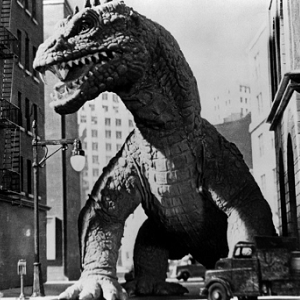
Rhedosaurus
CBUB Wins: 0
CBUB Losses: 1
CBUB Ties: 0
Win Percentage: 0%
Added by: Venom 2009
Read more about Rhedosaurus at: Wikipedia
Official Site: Warner Bros.
The Rhedosaurus is a fictional dinosaur that debuted in the 1953 monster film The Beast from 20,000 Fathoms, directed and co-written by Eugène Lourié. The Rhedosaurus is depicted as a giant, destructive, prehistoric reptile that is immune to most modern artillery in its major on-screen appearance, and would later appear in the 1977 science fiction film Planet of Dinosaurs.
The prehistoric sea monster that became the Rhedosaurus was initially conceived by the writer Ray Bradbury for his short story "The Fog Horn", which appeared in the June 23, 1951 issue of The Saturday Evening Post. Prior to deciding to adapt Bradbury's creature from the story and the artwork by James R. Bingham, Ray Harryhausen, and Eugène Lourié went through many draft designs for producers Hal E. Chester and Jack Dietz, who desired to make a monster film due to the successful 1952 re-release of King Kong (1933). After considering using existing dinosaurs such as an Allosaurus, Harryhausen and Lourié eventually decided to invent a new fictional creature; its appearance later infuriated scientists and students alike upon its release. The former ultimately made two models based on his concept art before concluding on a fearsome-looking design with the producers' approval and portraying the creature in the film via stop motion animation.
The Rhedosaurus is one of the most influential and iconic fictional monsters in the history of cinema. It inspired film monsters such as Godzilla and Gamera and set the template for giant monster and kaiju in films, including: Them! (1954), Godzilla (1954), The Deadly Mantis (1957), 20 Million Miles to Earth, The Giant Claw (both 1957), The Giant Behemoth (1959), Gorgo (1961), and Gamera, the Giant Monster (1965). Homages to the creature appear in media such as a 1956 issue of the comic book series Batman, the 1970 film When Dinosaurs Ruled the Earth, and the comic book miniseries Dinosaurs Attack!.
Since his debut in 1953, The Rhedosaurus has been featured in various entertainment mediums, in addition to comic books, novels, and television programs. With each appearance, artists would slightly change the character's design.
No Fantasy Draft Records Available
